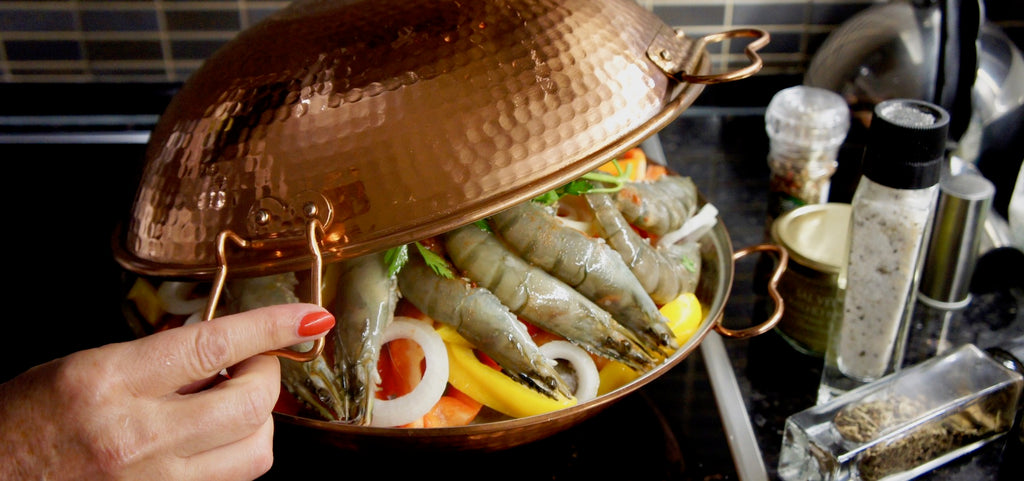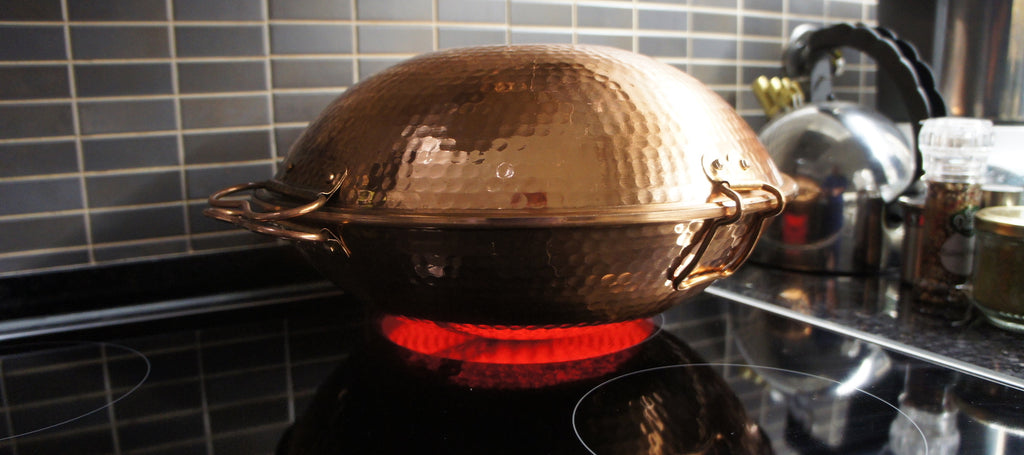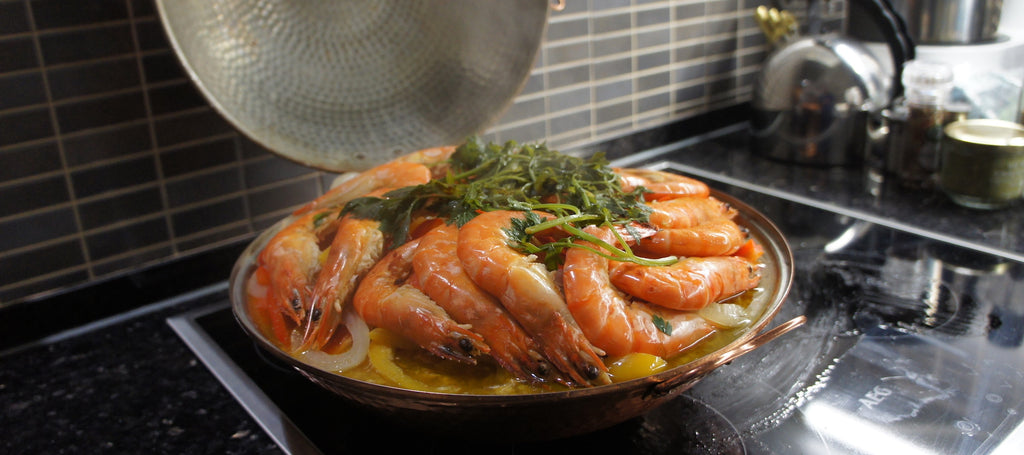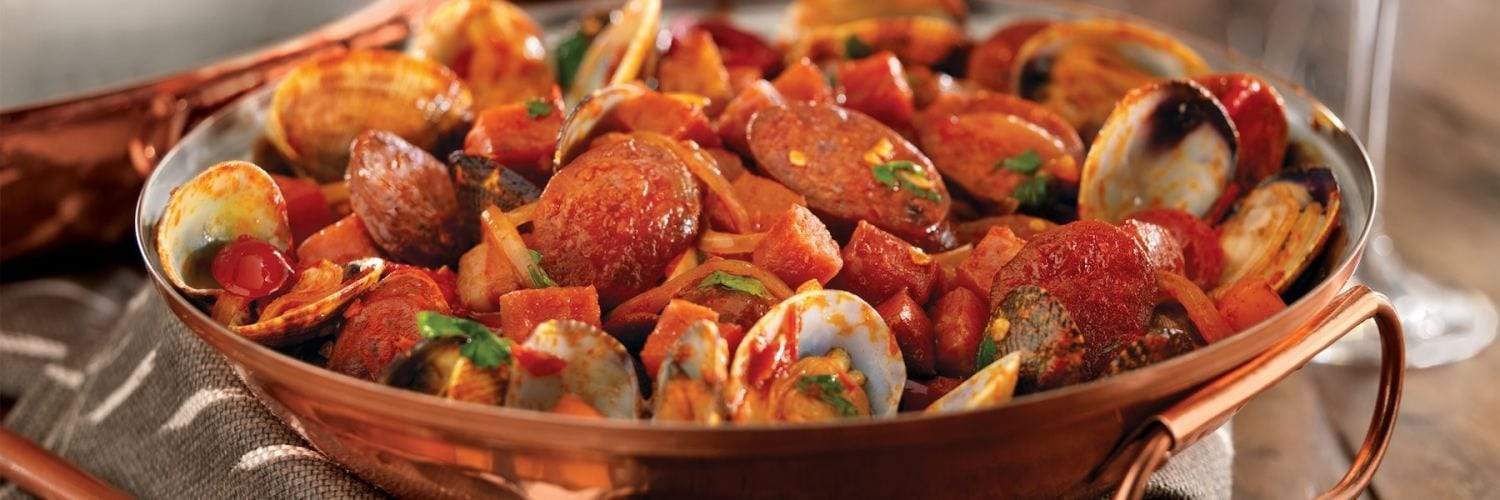Originally from the Algarve, the cataplana is a piece of cookware that gives its name to a great many recipes that are very popular in the south of Portugal.
The advantages of the Cataplana
This utensil is made of two copper half-shells joined by a hinge and fitted with a locking system.
A practical utensil
The first advantage of a cataplana is that it serves both for preparing and cooking the dish and for presenting it at the table. Mix your ingredients, put your cataplana on the heat, take it off once cooked, open it and place it directly on the table — it’s as simple as that.
Healthy cooking
The second advantage is the cooking method the cataplana enables. It requires very little fat and the gentle, sealed cooking preserves the texture, flavour and full goodness of the ingredients.
Easy recipes
A cataplana is super easy to use: fill it with your chosen ingredients (meat, fish, shellfish, vegetables, spices…), close it, put it on the heat and it cooks by itself. No need to stir or worry about the cooking. At the end of this article you’ll find a few recipes, some of them suggested by Vítor Sobral, one of Portugal’s best chefs.
Full of flavour
The shape of the cataplana allows it to close hermetically and cook with steam while capturing the juices from the ingredients, so that every last ingredient retains an extraordinary taste! You’ll easily find plenty of recipes online on various cooking sites. The principle is always the same.
How to choose your Cataplana?
Some will tell you that you can use a wok — don’t! Your dish would almost certainly be a failure. A cataplana is designed to distribute heat throughout its volume, ensuring even cooking. What’s more, cooking must take place in an enclosed space, which is exactly what the cataplana provides. In practice, you can choose between the traditional copper cataplana and a stainless-steel cataplana.
The copper Cataplana
The stainless-steel Cataplana
This is the only cataplana compatible with induction technology.
In any case, I recommend choosing a size that will allow you to make a cataplana for the maximum number of guests. This utensil is very robust and will last a lifetime. It would be a shame to find it too small on a regular basis.

Some tips for use
1 – A copper cataplana is very sturdy; nevertheless, it is advisable not to expose the copper to a direct flame or place it in the oven when empty, which could deform it.
2 – Copper is an excellent conductor of heat, so the cataplana does not need much heat to work perfectly. Bear this in mind when setting your hob.
3 – The inside of a cataplana is tinned to prevent food from sticking; do not use metal utensils for cooking and prefer wooden ones.
4 – Our cataplanas are not decorative objects, so they are not varnished, which means you do not need to treat them before use. However, do not use abrasive products or anything that could scratch or damage them.
Main cataplana recipes
In Portugal, there are practically as many cataplana recipes as there are cooks. The idea is to combine vegetables, fish and meats and cook everything together. From there, anything goes.
Here are the five simple steps for making a cataplana at home.





Nevertheless, here are a few recipes that you can easily adapt depending on the ingredients you find at the market.
Fish Cataplana

- Oil the bottom of the cataplana — with olive oil, of course!
- Cover the base with thin slices of vegetables (onions, tomatoes, peppers, potatoes or better still: sweet potatoes!).
- Season with salt and pepper and add coriander if you like it.
- Add the salted fish cut into pieces. Don’t hesitate to vary the species.
- Cover the fish with another layer of vegetables.
- Then add the seafood and shellfish (prawns, clams, cockles, mussels — your choice).
- Pour a glass of olive oil and half a glass of water evenly over everything.
- Cook on a very low heat without opening for 30 minutes and only open the cataplana at the moment of serving.
Pork and Clam Cataplana

My favourite recipe! It is inspired by a typically Portuguese dish — pork with clams cataplana. An original recipe I highly recommend.
- Cut the pork into pieces, place them in a dish and drizzle with white wine.
- Add, to taste, crushed garlic, paprika and bay leaves and marinate for at least 2 hours, preferably in the fridge.
- Peel, wash and slice the onions, parsley and coriander.
- Heat 4 tablespoons of olive oil over a medium heat in the cataplana.
- Add the onions and sauté for 5 minutes, then add the garlic and bay; season with salt and pepper to your taste.
- Add the pork pieces and then the clams; sprinkle with the parsley and coriander. Moisten with a little white wine.
- Close the cataplana and cook gently without opening for 30 minutes; only open at the moment of serving.
Carabineros Prawn Cataplana with Mushrooms & Rosemary

With the kind permission of Silampos and Chef Vítor Sobral
Ingredients (10 people)
- 800 g carabineros prawns, peeled with head and tail left on
- 350 g brown mushrooms
- 200 g sun-dried tomatoes
- 5 cloves of garlic
- 1 teaspoon rosemary
- 0.3 dl tomato vinegar
- 0.5 dl extra virgin olive oil
- Traditional sea salt
- Pepper
Method
- Sauté the tomatoes in 0.2 dl olive oil and set aside.
- Add the remaining oil to the cataplana.
- When it is hot, add the prawns previously seasoned with salt.
- Then add the mushrooms, garlic and rosemary.
- Put the lid on and leave to cook.
- Serve with a little pepper and vinegar.
Clam Cataplana with Lemon

With the kind permission of Silampos and Chef Vítor Sobral
Ingredients (10 people)
- 3 kg clams
- 400 g chopped onions
- 6 cloves of garlic, chopped
- 400 g peeled tomatoes, quartered
- 0.5 dl lemon juice
- 1.5 dl extra virgin olive oil
- Chilli
- Chopped chives
Method
- Brown the onions, garlic and tomato in the olive oil.
- Add the clams, chilli and lemon juice.
- Cover and bring the mixture to a gentle heat.
Across its 130 pages, this beautiful book offers nearly 70 very detailed traditional Portuguese recipes along with wine suggestions: petiscos, soups, fish, seafood, meat and desserts — everything you need to succeed with Portuguese recipes.




6 comments
Bonjour, pour les cataplana en cuivre est ce que l’on peut les utiliser sur le gaz à feu doux?
Merci
Bo jour, je reviens du Portugal et évidemment j ai goûter pour la 1er fois une cataplana dans laquelle il y avait des pomme de terre. Ma question est : dois-je laisser plus longtemps la cuisson s il y a des pomme de terre ? Merci
ola!!je viens de recevoir ma cataplana, elle est magnifique, dommage que les délais de livraison soient si long. c’est un cadeau qui devait arrivé pour noel. mais je pense que un mode d’emploi et même une petite recette aurait été un plus..j’ai du aller sur internet…et ces recettes que vous avez la bonté de diffuser, je n’arrive pas a les imprimer..dommage …mais je pense que je reviendrais quand même sur le site ou je retrouve mon ’Portugal’adoré.saudades
Bonjour Thérèse, nous indiquons les dimensions de chaque Cataplana sur sa fiche produit et faisons une estimations du nombre de convives que cela représente ce qui vous permet d’affiner votre choix.
Bonjour,
À combien de personnes la cataplana 36 cm correspond elle,
6/8 pers ou moins ou plus et à quel prix .
Merci de me renseigner
Salutations
P
Bonsoir, j ai bau coup cherchée sur internet la dimension à choisir pour l achat de cet article et tenant compte de votre article comment le choisir, je me décide pour une 5/6 personnes équivalente à 6/8 personnes.
En vous remerciant de vos Conseils dans votre article que je vais imprimer et mettre avec mes recettes portugaises que j aiment réalisées et appréciées pour ma famille et amis, amateurs de cuisine Portugaise.
Et commander de votre livre Recettes du Portugal .
En vous remerciant de vos conseils éclairés,
Recevez mes salutations.
DE WAELE Thérèse